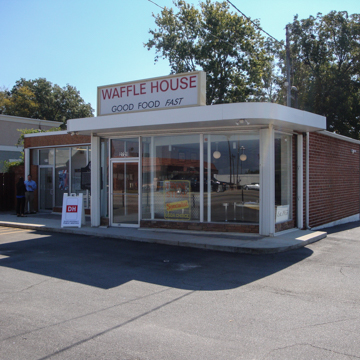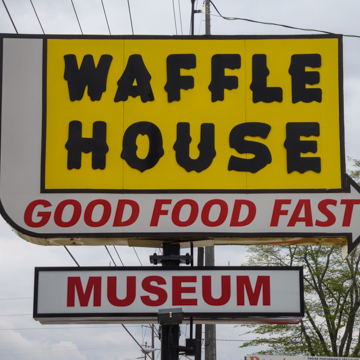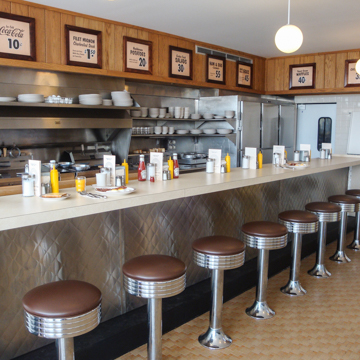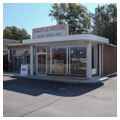You are here
Waffle House Museum
The Waffle House Museum preserves the first Waffle House restaurant, which opened in 1955 after neighbors Joe Rogers Sr. and Tom Forkner decided the Atlantic suburb of Avondale Estates needed a 24-hour restaurant. Their roadside restaurant became an empire that now boasts 1,700 restaurants in twenty-five states. Waffle Houses can be found at most interstate crossroads throughout the south and at multiple suburban and small town sites elsewhere in the region. The original Avondale Estates restaurant, a simple brick box with a floor-to-ceiling plate glass storefront, has been restored to its 1955 look, with original stools, counter, behind-the-counter equipment, condiment racks, and dinnerware. The museum displays Waffle House memorabilia from the past sixty years. The nearest still operating and open Waffle House is at 2850 East College Avenue, just down the street.
In the 1950s, Joe Rogers worked at Toddle House restaurants but discovered that employee-shared or sole ownership of restaurants was not an option within the chain. Discussions with Tom Forkner, a real estate agent in Avondale Estates, prompted both men to conclude that a manger-owned eatery would create a people-oriented enterprise that would be beneficial for associates and customers. On Labor Day of 1955, Rogers and Forkner opened the first Waffle House at this location, with no plans for others. Within two years, however, they opened a second unit and in 1961, the Waffle House chain grew to four restaurants. Rogers left Toddle House to work full-time at Waffle House and Forkner switched to full-time soon afterward.
Joe Rogers commissioned architect Clifford A. Nahser (1928–2010) to design the Waffle House restaurants based on the Avondale Estates prototype, and Nahser’s yellow-and-black scheme was soon familiar to drivers across the region. Nahser spent most of his architectural career with the public school system, but even after his retirement in 1988, he continued to design Waffle Houses out of his office in Roswell, Georgia. With Nahser’s help, Rogers and Forkner created an icon of American roadside pop culture, but the Waffle House developed a loyal customer base because of its early reputation for friendly service and its limited but flexible menu, full of a la carte options and combinations.
During the 1960s Waffle House grew into a chain of forty-eight restaurants, and it multiplied rapidly in the following decades. The founders returned to Avondale Estates in the early 2000s to open the 1,000th location. Today approximately 1,700 locations, marked by bright yellow signs, have served over 877 million waffles, 2.5 million eggs, and well over a billion cups of coffee. Each restaurant, by tradition and customer expectation, is open 24 hours per day, 365 days a year; the rumor is that Waffle House doors have no locks. Waffle House menus, crockery, signage, and furnishings have all been embalmed in this original Waffle House restaurant as a museum of popular culture, and much like a 2 a.m. “waffle pit stop” along the interstate, this place is just as you would expect it—a period room of midcentury commercial roadside architecture.
Writing Credits
If SAH Archipedia has been useful to you, please consider supporting it.
SAH Archipedia tells the story of the United States through its buildings, landscapes, and cities. This freely available resource empowers the public with authoritative knowledge that deepens their understanding and appreciation of the built environment. But the Society of Architectural Historians, which created SAH Archipedia with University of Virginia Press, needs your support to maintain the high-caliber research, writing, photography, cartography, editing, design, and programming that make SAH Archipedia a trusted online resource available to all who value the history of place, heritage tourism, and learning.





















